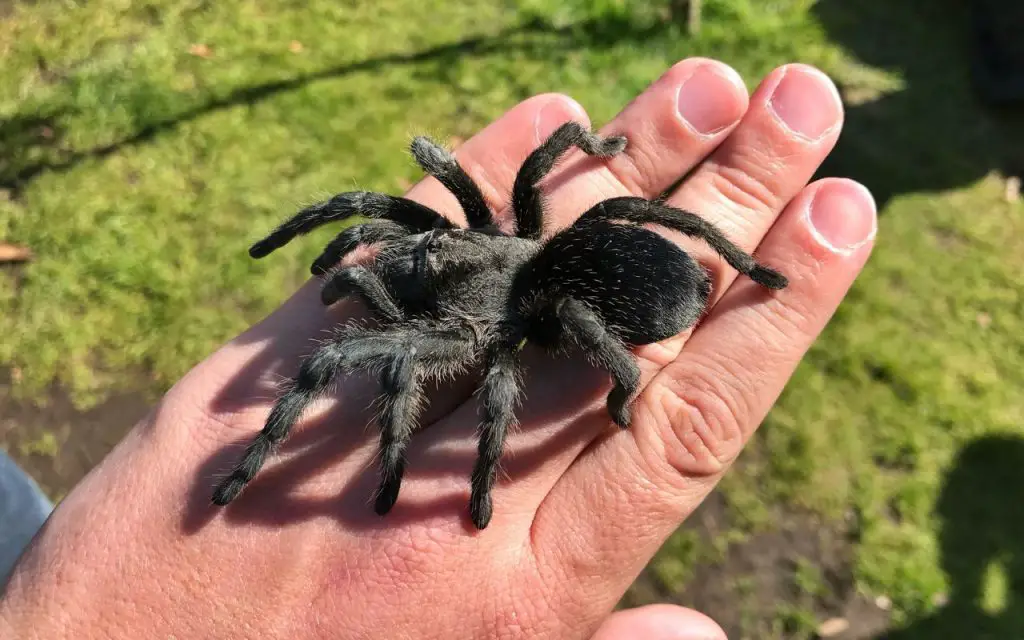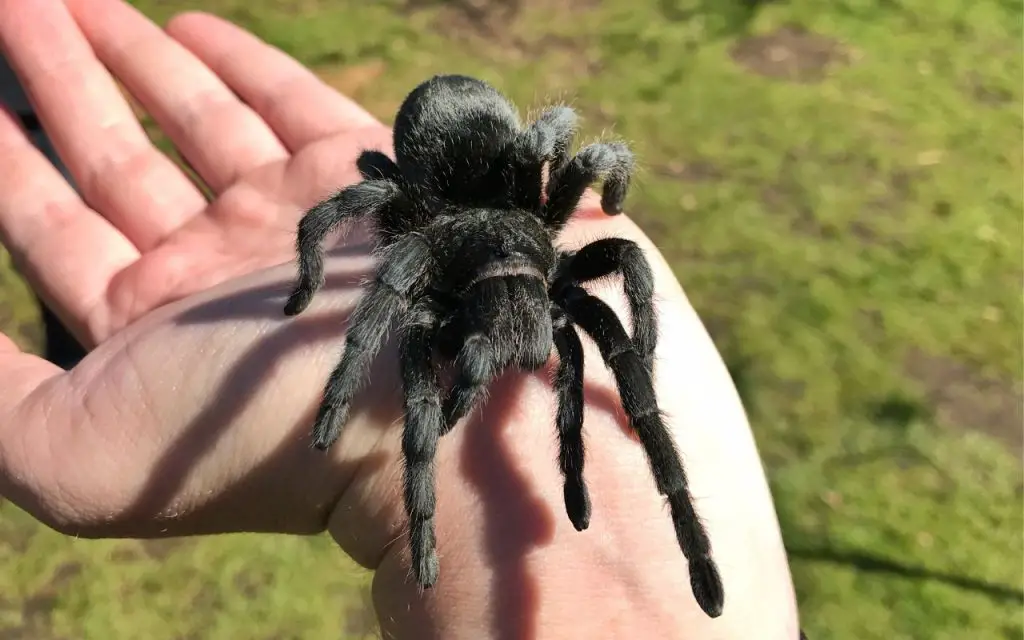Last updated on February 1st, 2023 at 09:55 am
Brazilian Black Tarantulas cost a little more than some of the more common pet tarantulas because of how popular they. That said, they are still reasonably affordable…
A Brazilian black tarantula can cost up to $100. The price is on the higher side as they are popular and sell fast. On the other hand, taking care of this tarantula species is extremely affordable as they survive on a steady diet of insects. The Brazilian black tarantula is the perfect species for first-time exotic pet owners.
Brazilian Black Tarantula for sale near me
Currently, there are several online and retail shops providing high-quality captive-bred black tarantulas. This species is quite rare in the United States but can be found, nonetheless.
It has gained immense popularity around the globe. The calm and docile nature of the tarantulas makes them appealing to first-time caretakers. With age, the spider gets pitch-black coloration. Undoubtedly it is one of the most amazing exotic pets one can buy.
Brazilian Black Tarantula size
These have a stout build and grow to medium size. When fully grown they reach up to a size of 8 inches.
The most common size is about 6 to 7 inches. Females typically have a life expectancy of 20 years whereas males have a relatively shorter lifespan ranging between 6 years to about 8 years.
This species of spider is thick and hairy. The species is mostly native to the grasslands of Uruguay and Brazil. Taking care of these beautiful spiders as pets is easy. They are known for having a docile and friendly nature which appeals to most people.
These spiders thrive in grassland. They make burrows underground and hide under dark logs, rocks, and thick vegetation. It keeps them safe from the eyes of predators and ambushes their prey.
People who keep these kinds of tarantulas as pets love the wooly and glossy bodies. Certain types of lighting can add a white or grey tone to their body color. These species of spider have solid black color without any patterns or colors.

What do Brazilian Black Tarantulas Eat
A balanced diet is crucial to help Brazilian Black tarantula sustain and grow in captivity. In their natural surrounding, these tarantulas are enthusiastic eaters. When kept as a pet young tarantulas should be given a diet of smaller foods like pinhead crickets, small mealworms, and fruit flies.
Feeding a mix of captive-bred locusts, dubia roaches, grasshoppers, moths, live crickets, and mealworms is suitable. Pinky mice and small lizards can be given to these spiders as occasional treats.
It is best not to give insects found outside as they can contaminate the tank with parasites. In some cases, it can even kill the spider. It is best not to include crickets in a tarantula’s diet as the live insects are known for irritating the spider.
During the juvenile phase, black tarantulas need to eat a couple of small insects every two days. Mature spiders of this species need to consume a single large insect or various small size insects twice every week.
A shallow bowl is the best way of giving water to the Brazilian black tarantula. Unfiltered tap water is adequate for the spider. The bowl should be replenished with fresh water regularly.
Brazilian Black Tarantula tank size
The best enclosure size for a fully-sized black tarantula is 12 inches by 10 inches. These species are known for burrowing in their natural habitat.
As a result, a bigger tank with added height will enable for a thicker layer of substrate inside. This will make room for the tarantula to dig. However, it is recommended that a bigger enclosure be purchased only if there is enough substrate.
If there is not enough substrate, the spider is likely to fall which can result in death or injury.
Ideally, the width of an enclosure is around 3 times the leg span of the spider. These spiders are mostly terrestrial and prefer to explore around. The wider the enclosure, the better.
Since Brazilian black tarantulas spend most time inside burrows and shade, lighting is not much important inside the tank. If the spider is kept inside a tank that has a window, it is likely to get sufficient light from the sun. Never put it near an actual window, though – that could overheat and kill it!

Brazilian Black Tarantula terrarium
In their natural habitat, these tarantulas are familiar with temperatures of around 65-85 degrees Fahrenheit. It is best to provide a similar temperature inside the enclosure.
- If the room temperature is sufficient there is no need of using additional heat inside the tank.
- When the temperature gets lower than 68°F, a heating pad can be placed. You can do it by putting the pad under one of the sides of the tank.
- This heating pad positioned inside the tank creates a heat flow. It enables the spider to alternate between warm and cool sides.
- It is also helpful in regulating the body temperature of the spider. Some people make use of a thermometer that helps keep the temperature in check.
- It is essential for ensuring that the tarantula’s tank is not extremely hot or vice-versa.
To ensure proper humidity inside the enclosure adding a dish of fresh water is helpful. Sometimes young spiders with shorter leg spans may need moist substrate and light misting.
Also, the enclosure should have sufficient ventilation. Instead of ventilating the tank from the highest part, making holes on the inside of the chamber allows for airflow.
Enclosure substrate
These black tarantulas are natural burrowers. Therefore, they require around 4 inches of the substrate inside the tank. The fiber of ground coconut and good-quality soil is the best material for creating the substrate.
However, it should be free from harmful chemicals. Substrates that are lightweight and airy are suitable for absorbing the right quantity of moisture. The substrate should be packed lightly for effortless burrowing.
It is best to avoid purchasing substrates that have sticks and other pieces. It might cause injury to the delicate morning of the spider.
Also, substrate material containing fertilizer and additives can make the spider sick. Aquarium gravel should not be used as it traps a lot of water and causes injury to the tarantula.
This is a species of spider that likes to have a plethora of spaces to hide in natural surroundings. Artificial plants, small potted plants, and curved cork pieces, and wood can give the spider a nice shelter inside the enclosure.
Most of these black tarantulas prefer to sleep inside their burrows. So it is critical to have a sufficient amount of substrate. There is no need of creating bedding inside the enclosure.

Cleaning the enclosure
Cleaning the enclosure at regular internal is equally important to avoid bad smells. It will also prevent the spider from falling sick. Conducting a deep cleaning of the tank quarterly is a good practice. The tank should be washed completely after removing all the present substrate and other substances.
The substrate and decorative items should be cleaned with water and dish soap. During spot cleaning of the tank, removing your spider is not necessary. Brazilian black tarantulas are known to move slowly so they will not escape when the hatch is open.
It is best to keep the tarantula in another tank for thorough cleaning. Putting similar decorations in the temporary tank will put the tarantula in a comfortable space.
Using warm water is effective for cleaning the tank. For harder spots using a small quantity of soap should help. Avoid the use of chemical cleaners or bleach as fumes can kill the tarantula.
This species of spider is famous for its easy-going nature and does not demand much care. These are perfect pets for people who are just beginning to be spider owners.
Juvenile Brazilian Black Tarantula for sale
These specific tarantulas are preferred around the globe for their docile nature. Their calm temperament makes them suitable for children and beginners. The life expectancy is around 20 years and some can even live up to 40 years.
It makes for an excellent display tarantula. Juvenile black tarantulas are always hard to find and expensive but worth the money.

How fast do Brazilian black tarantulas grow?
Black tarantulas grow slowly and can take around 8 years to reach maturity. The females always outlive the males by several years.
When fully grown, they can reach anywhere from 6 to 8 inches (15-20cm) in total legspan. Males and females reach a similar diameter, but the males tend to be much slimmer looking compared with females. This one reason why it’s easy for females to eat them if they feel like it!
Brazilian Black Tarantula lifespan
The females of this species are expected to live for 20 years. On the other hand, males have a relatively shorter lifespan of about 6-8 years.
In captivity, you must focus on providing good husbandry for them to live this long. Check their humidity and temperature regularly, and provide them with an appropriate insect diet.
All-in-all, the most common killer of pet tarantulas is incorrect humidity, so this is your main point to look out for.

FAQ relating to how much Brazilian Black Tarantulas cost
How much is a Brazilian black spider?
Finding Brazilian Black Tarantulas for sale can be a little challenging. When you, they tend to cost just a little more than other common species, namely $65-100. As you’d expect, spiderlings under 1 inch in legspan are usually cheaper than adults. Males may also be cheaper than females.
Are Brazilian black tarantulas friendly?
Black tarantulas are known for having a calm and docile nature. These make for great pets for beginner spider keepers and children. In my experience they can be handled safely if you are careful. They should only be handled a couple of inches above the floor, never standing up. Remember, falls can easily kill a tarantula.
How big do Brazilian black tarantulas get?
They can grow up to a size of 6 to 8 inches (15-20cm) and have a stout build. Their solid black color makes them look larger and more intimidating than they are. Don’t be fooled though – these are some of the most docile tarantulas available in the pet trade.
How long do Brazilian black tarantulas take to grow?
This species of tarantula grows slowly and can take more than 8 years to mature. As is observed with all varieties of tarantulas the females live longer than the males by several years. If you would like a fast-growing species, opt for the Curly Hair Tarantula, for example.







